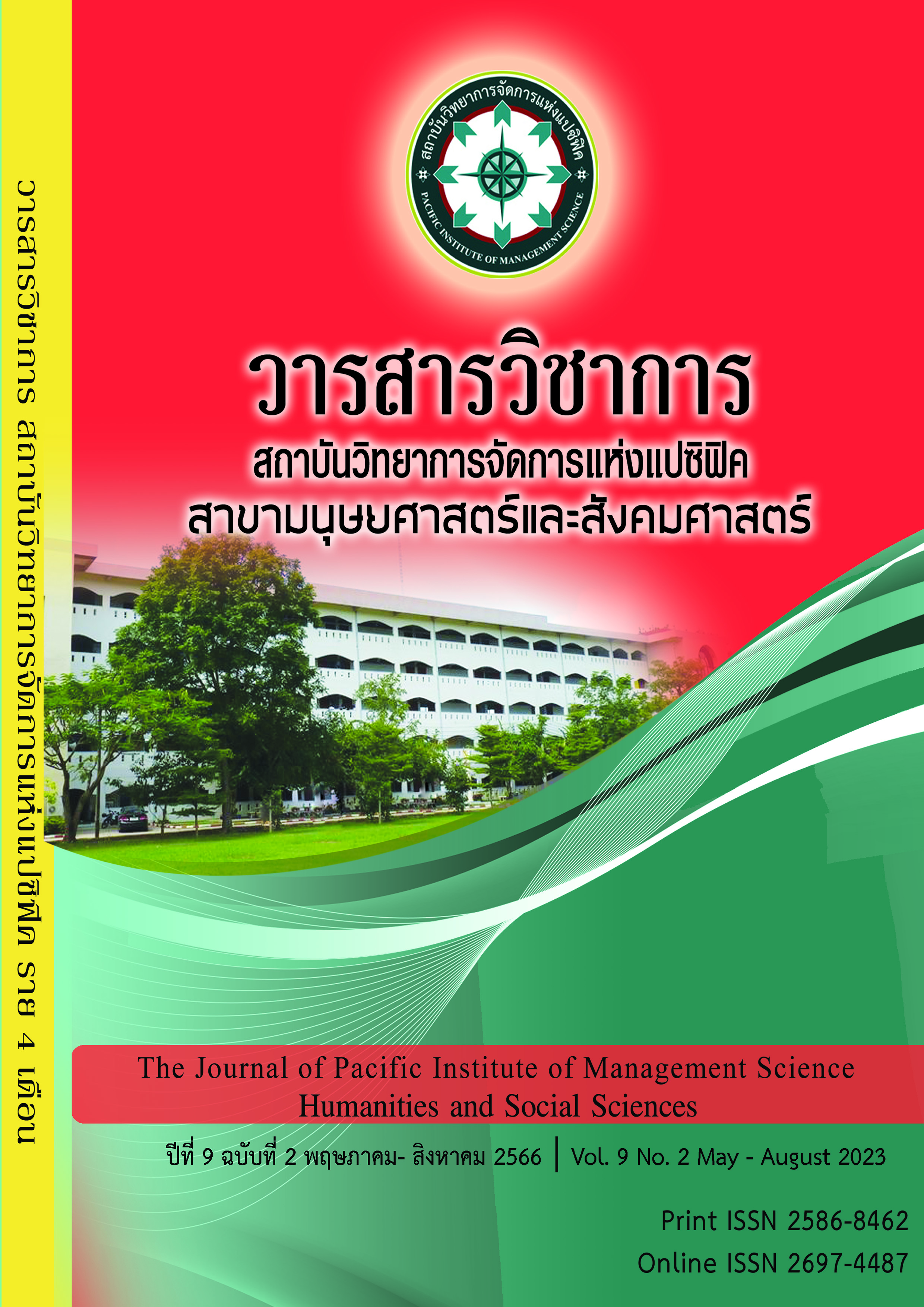Development of mathayomsuksa 6 students' problem-solving skills for physics content on magnetic field from electric current flowing through conductors by using a 5-step inquiring-based learning management combined with a STEM-based education.
Keywords:
5-step inquiry-based learning management, STEM-based learning management, Science problem solving skillsAbstract
This research investigated an integrated learning management method using a 5-step inquiry-based learning management system combined with a STEM-based learning management system. The objective was to develop problem-solving skills about electric current flowing through the coil in the physics subject of Mathayomsuksa 6 students at Thung Song School. Nakhon Si Thammarat Province, for 40 students. After the learning management experiment, students' problem-solving skills were assessed at different stages of the learning management process and also evaluated the satisfaction of various issues used in learning management. The obtained scores will be compared with the 5-level average score criteria. The results show that (1) Students have increased problem-solving skills at every step as assigned by the teacher. Before being managed to learn The student's problem solving ability scores were 7.5% very good, 45.0% moderate, 45.0% low, and 2.5% should be improved. After applied this technique, the high level problem solving skills were obtained. There was very good level increased to 17.5%, the good level increased to 50.0% and the moderate level was 32.5%. In addition, when considering problem-solving skills according to the stages of learning management. It was found that the step in which the students' scores are increased. The concept related to the problem increased by 33.5%, the problem-solving design stage increased by 31.1%, the testing, evaluation and improvement stage increased by 29.0%, the identification of problems or situations increased by 25.0%, the proposing solutions increased by 25.0% and the planning to implement solutions increased by 24.8%. (2) The results of the satisfaction assessment of the students after receiving the 5-step search-based learning management in conjunction with the STEM-based learning management show that mean value was 4.24 and the standard deviation was 0.75, which was in a high level.
References
กระทรวงศึกษาธิการ. (2560). หลักสูตรแกนกลางการศึกษาขั้นพื้นฐาน พุทธศักราช 2551 (ฉบับปรับปรุง พ.ศ.2560). กรุงเทพฯ : โรงพิมพ์ชุมนุมสหกรณ์การเกษตรแห่งประเทศไทย จำกัด.
ฐายิกา ชูสุวรรณ. (2560). ผลการสอนวิชาฟิสิกส์โดยใช้แนวทางการจัดการศึกษาแบบสะเต็มเรื่อง แสงที่มีต่อทักษะกระบวนการทางวิทยาศาสตร์และเจตคติทางวิทยาศาสตร์ ของนักเรียนชั้นมัธยมศึกษาปีที่ 5 โรงเรียนมัธยมศึกษาขนาดกลางในจังหวัดพระนครศรีอยุธยา. วิทยานิพนธ์ศึกษาศาสตร์มหาบัณฑิต คณะศึกษาศาสตร์ มหาวิทยาลัยสุโขทัยธรรมาธิราช.
ธนภัค แสงมุนี. (2559). การสอนแบบสืบเสาะหาความรู้ (5Es). สืบค้นเมื่อ มีนาคม 2564. จาก http://www.Thaischool.in.th.
นิตยารัตน์ คงนาลึก. (2562). เอกสารประกอบการสอนรายวิชาการประเมินผลการเรียนรู้. นครศรีธรรมราช คณะครุศาสตร์ มหาวิทยาลัยราชภัฏนครศรีธรรมราช
นรรัชต์ ฝันเชียร. (2563). เรื่องน่ารู้เกี่ยวกับสะเต็มศึกษา(STEM). สืบค้นเมื่อ ธันวาคม 2563. จาก http://www.truplookpanya.com
น้ำเพชร กะการดี. (2560). การจัดการเรียนรู้แบบบูรณาการโดยใช้รูปแบบสะเต็มศึกษาเพื่อพัฒนาผลสัมฤทธิ์ทางการเรียนและความคิดสร้างสรรค์ เรื่อง แรงและการเคลื่อนที่ ระดับชั้นมัธยมศึกษาปีที่ 3. วิทยานิพนธ์ ครุศาสตรมหาบัณฑิต คณะครุศาสตร์ มหาวิทยาลัยราชภัฏมหาสารคาม.
วรันญา วิรัสสะ. (2562). การศึกษาหาความสัมพันธ์ของเจตคติต่อวิทยาศาสตร์กับทักษะกระบวนการทางวิทยาศาสตร์ ของนักเรียนชั้นมัธยมศึกษาปีที่ 1 ในจังหวัดสิงห์บุรี สังกัดโรงเรียนเขตพื้นที่การศึกษามัธยมศึกษาเขต 5. วารสารมหาวิทยาลัยปทุมธานี, 11(2), 130-141.
วศิณีส์ อิศรเสนา ณ อยุธยา. (2559). เรื่องน่ารู้เกี่ยวกับ STEM Education (สะเต็มศึกษา). กรุงเทพฯ: สำนักพิมพ์แห่งจุฬาลงกรณ์มหาวิทยาลัย.
วิชัดชณา จิตรักศิลป์. (2560). การพัฒนาทักษะกระบวนการทางวิทยาศาสตร์โดยการจัดการเรียนรู้แบบสะ เต็มศึกษาเรื่อง แรง การเคลื่อนที่และพลังงาน กลุ่มสาระการเรียนรู้วิทยาศาสตร์ ชั้นมัธยมศึกษาปีที่ 1. วิทยานิพนธ์ครุศาสตรมหาบัณฑิต คณะครุศาสตร์ มหาวิทยาลัยราชภัฏสกลนคร.
สถาบันส่งเสริมการสอนวิทยาศาสตร์และเทคโนโลยีสถาบันสงเสริมการสอนวิทยาศาสตร์และเทคโนโลยี.(2557). คู่มือกิจกรรมสะเต็ม ระดับมัธยมศึกษาปีที่4-6. กรุงเทพฯ: กระทรวงศึกษาธิการ.
สุภาวดี สาระวัน. (2561). สะเต็มกับความหลากหลายทางการศึกษา. สืบค้นเมื่อ 22 ธันวาคม 2563. จาก http://www.scimath.org.
สมชาย อุ่นแก้ว. (2561). วิธีการสอนแบบสะเต็มศึกษา (STEM Education). สืบค้นเมื่อ 22 ธันวาคม 2563. จาก http://www.kids.ru.ac.th.
สำนักวิชาการและมาตรฐานการศึกษา. (2551). ตัวชี้วัดและสาระการเรียนรู้แกนกลางกลุ่มสาระการเรียนรู้ วิทยาศาสตร์ ตามหลักสูตรแกนกลางการศึกษาขั้นพื้นฐาน พุทธศักราช 2551. กรุงเทพมหานคร: โรงพิมพ์ชุมนุมสหกรณ์การเกษตรแห่งประเทศไทยจำกัด.
Downloads
Published
Issue
Section
License
Copyright (c) 2023 Pacific Institute of Management Science

This work is licensed under a Creative Commons Attribution-NonCommercial-NoDerivatives 4.0 International License.
บทความที่ได้รับการตีพิมพ์เป็นลิขสิทธิ์ของ สถาบันวิทยาการจัดการแห่งแปซิฟิค
ข้อความที่ปรากฏในบทความแต่ละเรื่องในวารสารวิชาการเล่มนี้เป็นความคิดเห็นส่วนตัวของผู้เขียนแต่ละท่านไม่เกี่ยวข้องกับสถาบันวิทยาการจัดการแห่งแปซิฟิค และคณาจารย์ท่านอื่นๆในสถาบันฯ แต่อย่างใด ความรับผิดชอบองค์ประกอบทั้งหมดของบทความแต่ละเรื่องเป็นของผู้เขียนแต่ละท่าน หากมีความผิดพลาดใดๆ ผู้เขียนแต่ละท่านจะรับผิดชอบบทความของตนเองแต่ผู้เดียว







